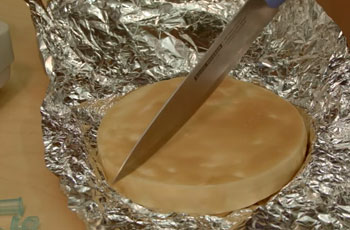Ryan Bethencourt
The future of food
We could soon have lab-grown hamburgers, not in the $300,000 range but in the $10 range — would you eat one?
Editor’s note: this is an excerpt from the latest edition of BioCoder; it is republished here with permission. Get your free copy of BioCoder Fall 2014 here.

Screenshot from the Real Vegan Cheese Indiegogo campaign video.
That was the call I got from a scientist entrepreneur friend of mine, John Schloendorn, the CEO of Gene and Cell Technologies. He’d been working on potential regenerative medicine therapies and tinkering with bioreactors to grow human cell lines. He left the lab for the weekend, and then something went wrong with one of his bioreactors: something got stuck in it.
“So, I was wondering what happened with my bioreactor and how this big chunk of plastic had gotten in there and ruined my cytokine production run. I was pulling it out, and I thought it was was weird because it was floppy. I threw it in the garbage. A little later, after thinking about it, I realized it wasn’t plastic and pulled it out of the garbage.” Read more…
Craig Venter on moving at the speed of light
My discussion with Venter left me with a sense of wonder and excitement for biotechnology and the future.
Last week I had the privilege of speaking with J. Craig Venter at the Hillside Club in Berkeley, as part of the Bay Area Science Festival. Dr. Venter is a pioneer in biotech, from sequencing the Human Genome to creating a synthetic organism. It was an exciting moment for me, personally, as he thinks in terms of moonshots and succeeds often (through the failures).
Dr. Venter was in Berkeley as part of his tour to promote his new book, Life at the Speed of Light, which was inspired by Erwin Schroedinger’s question in 1943, “What is Life?” That question set Dr. Venter off on a life-long quest: first, to first take life apart and then rebuild it; to test his understanding of the machinery of life; and, ultimately, prove that he and humanity could rebuild life from scratch. The machinery of life still involves a lot of mystery, even for the simplest synthetic organisms. When when they were building the first synthetic organism, they focused on the minimum number of genes needed to create a viable life form. They found that they needed to include 50 genes with unknown functions. Without these genes, they couldn’t get the organism to “boot up.” They are clearly necessary, but why? What do they do? We still don’t know.
Venter also shared his thoughts on life on Mars. He thinks it is likely that life has existed on Mars, as Earth and Mars regularly exchange large amounts of particulate matter filled with bacteria. He’s planning a project to sequence Martian DNA (which he believes exists), with a plan to send the digital DNA sequence back to Earth for re-synthesis. Read more…
The biocoding revolution
The potential for synthetic biology and biotechnology is vast; we all have an opportunity to create the future together.
What is biocoding? For those of you who have been following the biotechnology industry, you’ll have heard of the rapid advances in genome sequencing. Our ability to read the language of life has advanced dramatically, but only recently have we been able to start writing the language of life at scale.
The first large-scale biocoding success was in 2010, when Craig Venter (one of my scientific heroes) wrote up the genome of an entirely synthetic organism, booted it up and created de novo life. Venter’s new book, Life at the Speed of Light, discusses the creation of the first synthetic life form. In his book and in video interviews, Venter talks about the importance of ensuring the accuracy of the DNA code they designed. One small deletion of a base (one of the four letters that make up the biological equivalent of 1s and 0s) resulted in a reading frame shift that left them with gibberish genomes, a mistake they were able to find and correct. One of the most amusing parts of Venter’s work was that they were able to encode sequences in the DNA to represent each letter of the English alphabet. Their watermark included the names of their collaborators, famous quotes, an explanation of the coding system used, and a URL for those who crack the code written in the DNA. Welcome to the future — and let me know if you crack the code!
Biocoding is just the beginning of the rise of the true biohackers. This is a community of several thousand people, with skill sets ranging from self-taught software hackers to biology postdocs who are impatient with the structure of traditional lab work. Read more…
Biotech’s Cambrian Era
Announcing BioCoder, an insider's review of DIY biotech
As I write this article, I’m reflecting on the long expanses of otherworldly playa I’ve just left, watching sandstorms pass in front of me while in altered mental states and contemplating the future of our beloved biotech industry.
I have, until recently been living a double life with one foot in the corporate biotech world and another deeply in the world of biohacking/radical science (working on DIY biolabs and equipment, longevity research, and ALS therapeutic development). I believe in the principles of citizen science and shared (or at least leaky) IP as a means of accelerating scientific progress, but I felt I needed to play my part in the “real” biotech industry. That changed three months ago when I realized that to create the innovation we want in biotech, we may have to burn the bridges that got us here and re-create it ourselves, with or without the dinosaur the current biotech industry has become.
